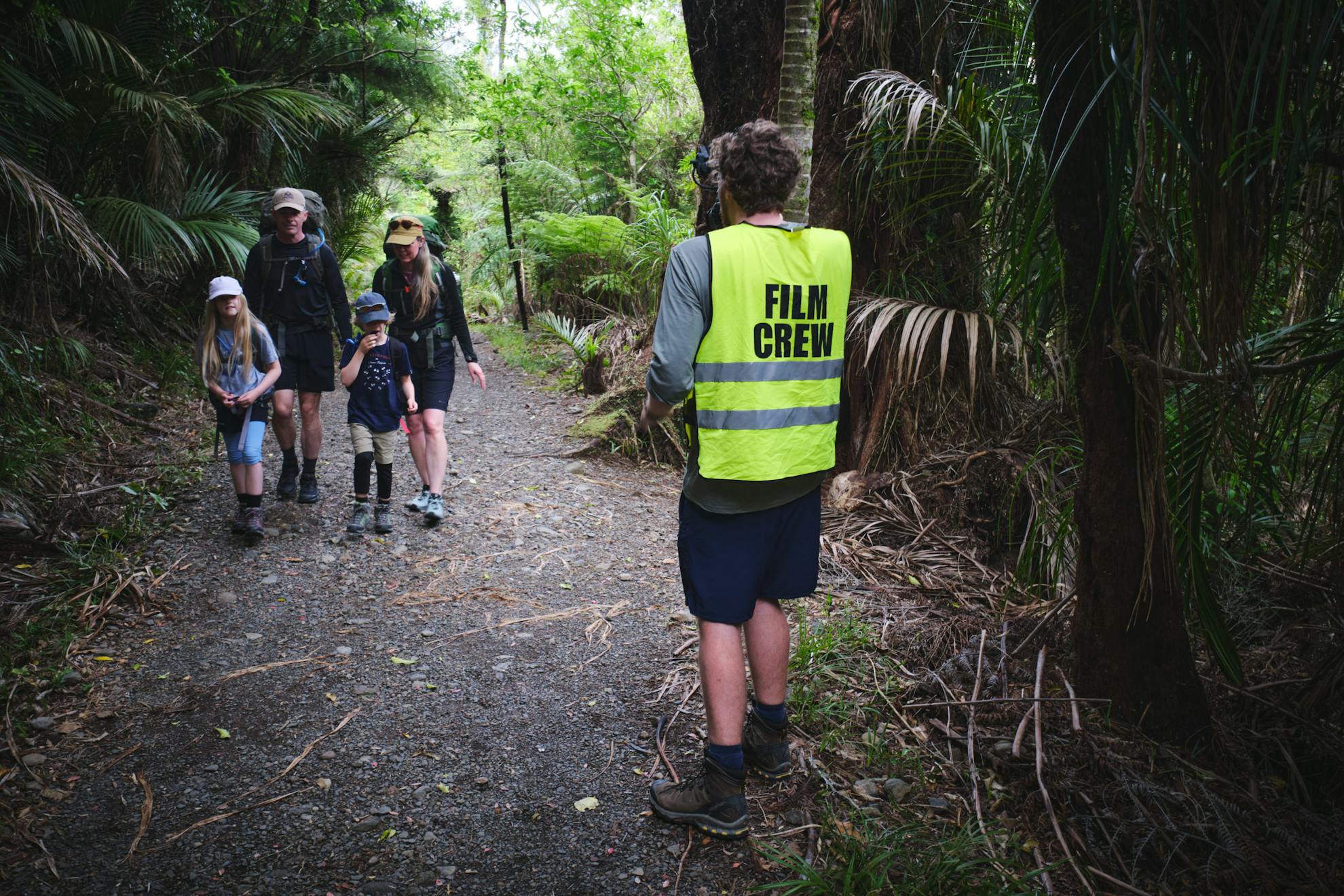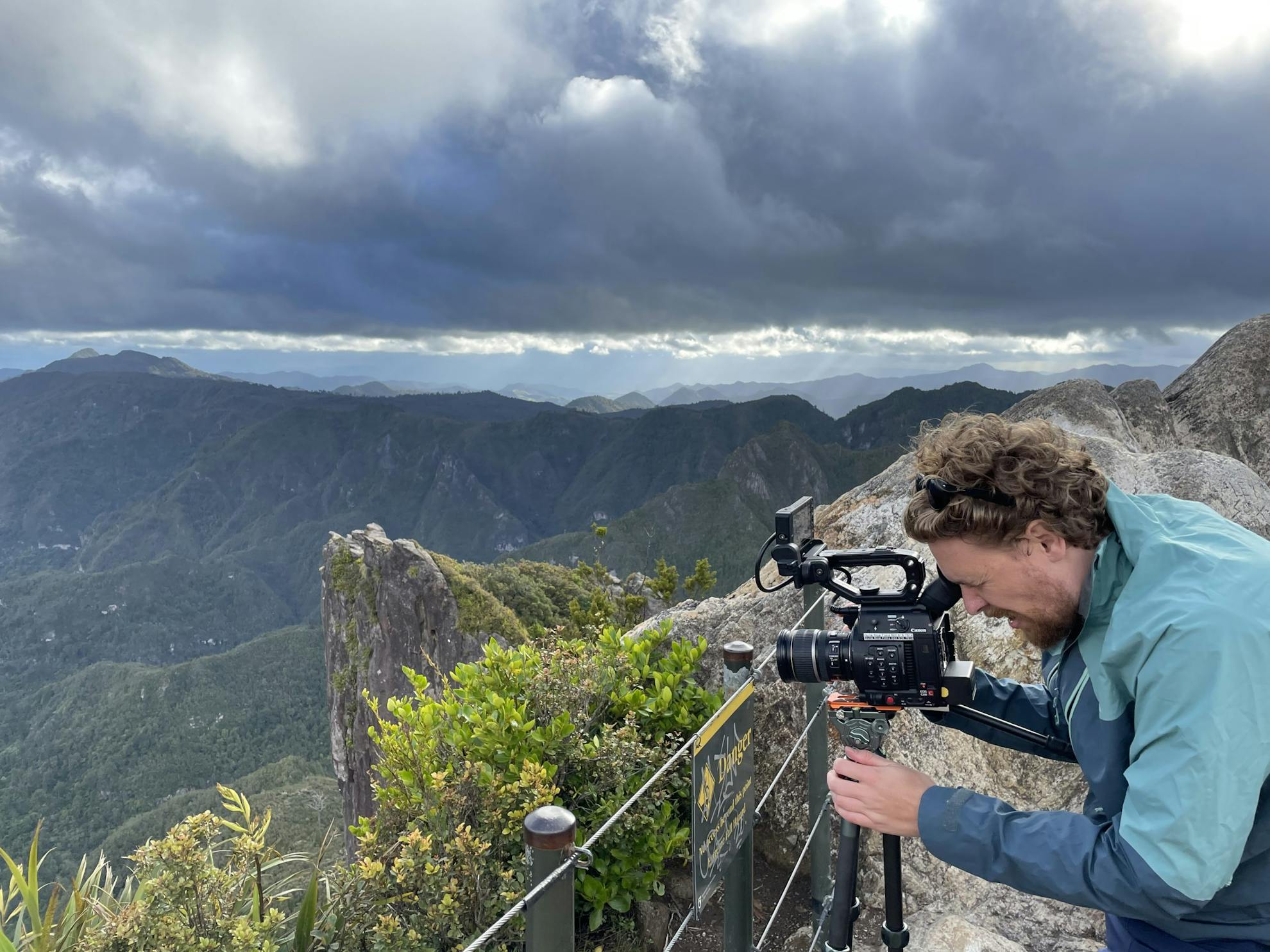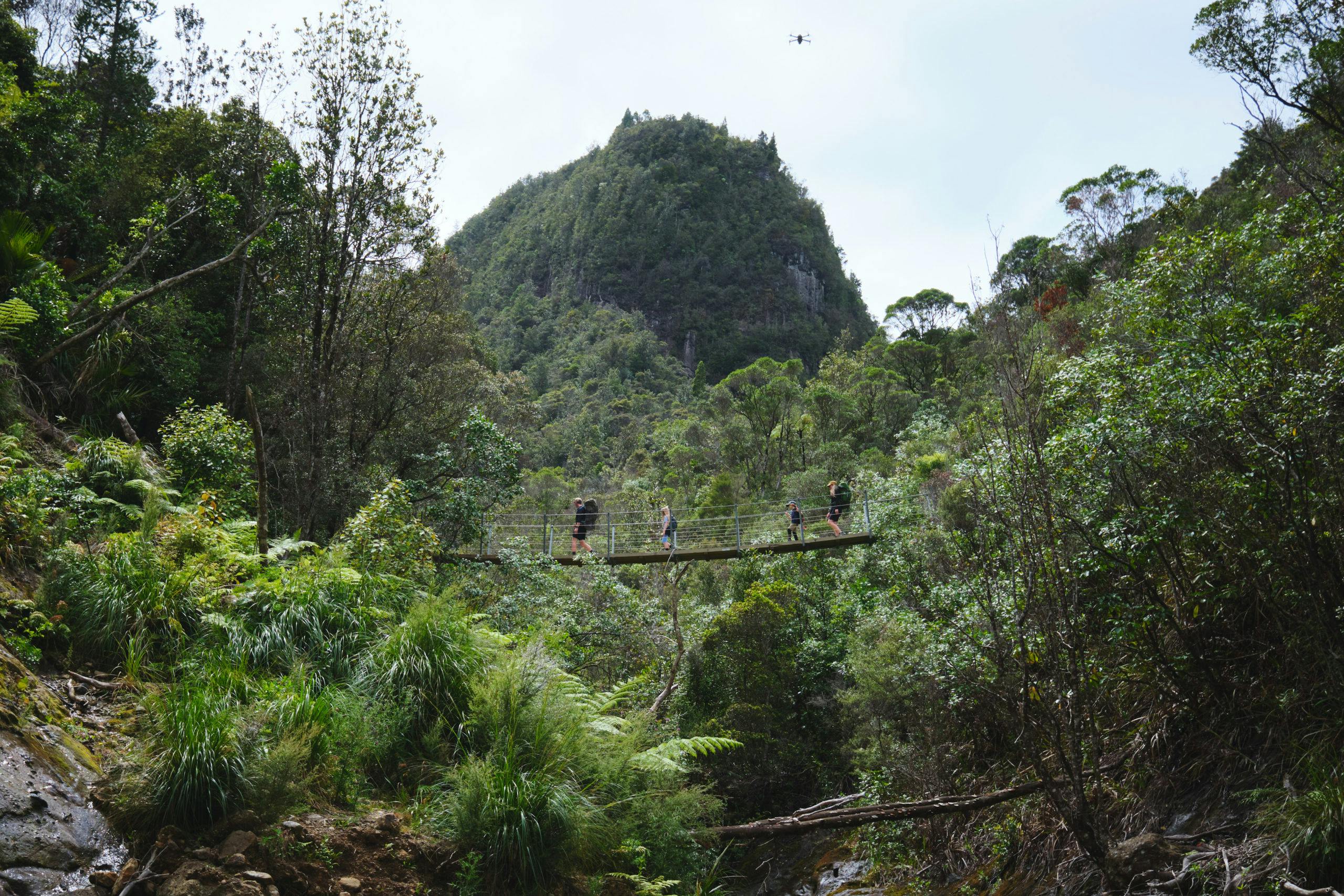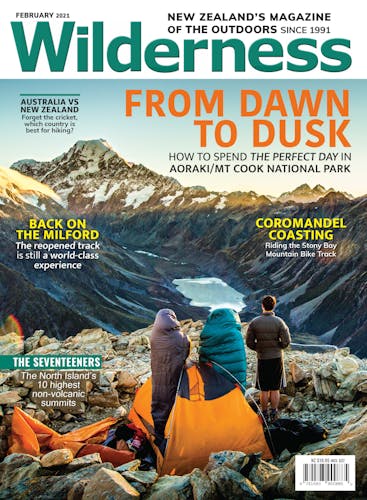Wilderness joins the Mountain Safety Council on the Kauaeranga Kauri Trail to film a tramping safety video.
As the film crew unloads into the Kauaeranga Valley car park, I’m relieved to be carrying a half-full day pack. I’m used to hauling a lot of camera gear, but nothing like this.
The drone batteries alone weigh twice as much as the mirrorless camera I’ve packed, and that’s the tip of the iceberg. When filming in the outdoors, every backup needs a backup. There are two drones – one so big its rotors are pushed through holes cut through a modified multi-day pack – a 360 camera, film cameras, tripods, and of course, trusty high vis vests.
The talent – Mountain Safety Council chief executive Mike Daisley, his wife Tina and their two kids – are also prepping for the tramp; sorting food, sleeping gear and clothes between four packs. The shots may be staged, but the tramp is not, and the family will need to carry everything for their overnight trip to Pinnacles Hut. It will be the first night spent in a hut for Natali, 8, and Thor, 6, and in spite of a bout of car sickness en route, they’re ready for the four-hour walk.
My job today is easiest of all; I’m accompanying the MSC as far as the hut, observing as they film the latest chapter in their tramping safety video series.
With 80 bunks, Pinnacles Hut is the largest-capacity DOC hut in the country and its popularity as an entry level tramping destination – particularly with families – has made it a priority for the video series.
MSC’s Tom Harris recalls his first visit there while we trudge up the track; the hut was his first overnight tramp, as well as mine, and we both have fond memories of walking the track at a young age with our parents.
In winter, Harris is the council’s alpine advisor, but this summer he’s leaving avalanche safety behind to take charge of the upcoming suite of seven safety videos.
Where the first season focused mostly on troublesome alpine routes, the second will introduce two family oriented routes, Kauaeranga Kauri Trail and Mt Somers Track in Canterbury, along with five more difficult tramps.
“We want to appeal to families getting into tramping, and encourage good habits,” Harris says.
Choosing which tracks to cover is the first step in the filmmaking process, he explains.
“We weight a number of walks based on search and rescue incidents, injuries and fatalities, but then also things like popularity and whether they are exposed to extreme weather,” Harris says.
MSC then approaches DOC with its list of proposed walks to ensure they align with the department’s priorities, and consultation begins. For each track, the best brains from DOC, LandSAR, maintenance teams and local guides are assembled and picked.
“We gather around a map at a table and talk it through for hours and hours, looking at the places to focus on, and where to make sure we are filming,” Harris says.
When principal photography and scriptwriting is complete, a draft video is sent back to the assembly for approval and fine-tuning before release. The next – and arguably most important – step is sharing the videos with those who will benefit most from the information.
“We try to pick the places that put [videos] in front of people rather than have them have to dig around to find them,” Harris says.
Amongst the most popular spaces for viewing are the DOC and Metservice websites, where the videos are displayed on the relevant track, national park and weather pages.
They’re also a hit at DOC visitor centres, Harris says.
“Some staff have said they play them on loop to explain to people how narrow a track is or how exposed a ridgeline is or how windy it can get,” he says.

“If they just tell people, some will get it, and some won’t. But if they show them on a video, everyone gets it.”
‘Getting it’ looks different, person to person, Harris says.
“For some people, it means they’re more prepared when they go, but we’ve also heard of people who watch it and say ‘actually, that’s too much for me and I want to do something a bit more straightforward’,” he says.
Back on the Kauaeranga Kauri Trail, we stop to film the water-logged stone steps – a major slipping hazard identified by DOC staff, and also by our sliding feet. Also on the list of identified hazards are weather, river crossings, the steep final scramble and unstable overhangs at the summit.
Harris believes showing people the realities of a track on video can be a more effective deterrent than a verbal warning.
“If you just give them the information you want them to know, it lets them make the choice. If you tell them not to walk, in many cases it drives people more – like it’s a challenge,” he says.
The first series of videos included three Great Walks, the Tongariro Alpine Crossing, and nine other tracks identified as dangerous to trampers. Combined, they’ve had around half a million views.
Mike Daisley says the videos fill a gap in outdoor education and reach more people than was possible when MSC ran training courses.
“We knew roughly how many people were getting connected with that training, and it was a couple of thousand a year,” he says.
“When you put that against the backdrop of a million and a half internationals doing tramping of some sort, pre-Covid, and three-quarters of a million Kiwis doing the same thing – there was a gap, and no one was connecting to them.”
MSC withdrew its outdoor safety programme in 2015 to focus on key messaging – a move which puzzled a number of outdoor trainers. Daisley explains it was a case of too many fish in the same pond.
“There is a whole fabric of outdoor training in New Zealand, and MSC was in the same ecosystem,” he says. “We asked if we were to take ourselves out of that space, what would be missing?

“When you have a number of organisations doing prevention work, it works so long as there isn’t much overlap, and you don’t get gaps. But if there are gaps in the system, that’s a bigger problem than having too many people doing similar things.”
Daisley says the New Zealand outdoors was “a different beast” in 1965 when MSC was formed.
“There were more specialist, knowledgeable people going into the outdoors doing very specific things; wayfinding new tracks, hunting, forestry service, track building,” he says.
“Getting these people together and training them was a fantastic way to give them those key survival skills, and it was part of that psyche – people were keen to learn that way.”
Outdoor courses still have their place, Daisley says, but it’s difficult to target them to the millions of track users who need them but don’t know it.
“There is a spectrum from people who are aware they are unaware through to the people who are unaware they are unaware – they don’t know there is a problem to be worried about,” he says.
“We were spending a lot of time educating the demographic not getting into trouble, so those people get better and better, but those people aren’t the problem.”
The safety videos are perhaps the most visible way MSC works to promote safety in the backcountry, but it also works behind the scenes to improve track signage and infrastructure, Daisley says. “It could be a simple message to say the track takes three hours, or five in bad weather, which is seemingly simple and obvious to dedicated trampers, but not obvious to the people having incidents.”
As we reach the final descent to the hut, I realise it’s time for me to begin my descent and return home to Auckland. The MSC team is just getting started, however, and still has a lot of filming ahead at the summit, and on the return journey via Billygoat Track.
In the coming months, videos will be filmed on the Southern Crossing, Richmond Range, Copland Valley, Rees-Dart Track, Gillespie Pass Circuit and Mt Somers Track.
People will still have accidents on these tracks – it’s inevitable – but Daisley believes the videos can make a difference to the number of preventable incidents.
“We’re humans, we fall down, but when you take [the accident aspect] out, you’re left with people who are making poor decisions because they have poor information or they’re motivated by something,” he says.
And with tramping accidents tracking down, despite increasing participation, Daisley is positive MSC’s work is preventing those incidents.
“We do believe, based on behaviour change research, that it’s the nudges – small though they are – that we are making,” he says.








